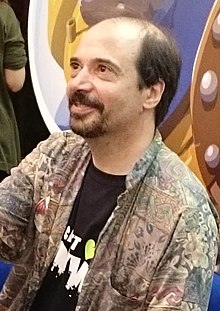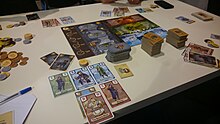Game design career
Precursors and development of Magic: the Gathering
While searching for a publisher for RoboRally, which he designed in 1985, Wizards of the Coast began talking to Garfield through Mike Davis, but Wizards was still a new company and felt the game would be too expensive to produce. : 278 Peter Adkison of Wizards of the Coast expressed interest in a fast-playing game with minimal equipment, something that would be popular at a game convention. Adkison asked if Garfield could develop a game with lower production costs than RoboRally, with the idea of making such a game more portable and easy to bring to conventions; Garfield thought of an idea that came from combining a card game with collecting baseball cards and spent a week creating a full game from that rough idea. : 278
Garfield had been creating card games since at least 1982, starting with a card game called "Five Magics" that was inspired by Cosmic Encounter, and his work with this new card game built on his existing older prototypes. : 278 Garfield thus combined ideas from two previous games to invent the first trading card game, Magic: The Gathering. At first, Garfield and Adkison called the game "Manaclash," and worked on it in secret during a lawsuit filed by Palladium Games against Wizards, and were able to protect the game's intellectual property by using the shell company Garfield Games. : 278 Garfield began designing Magic as a Penn graduate student. Garfield's playtesters were mostly fellow Penn students.
Wizards of the Coast
Magic: The Gathering launched in 1993. Playtesters began independently developing expansion packs, which were then passed to Garfield for his final edit. In June 1994, Garfield left academia to join Wizards of the Coast as a full-time game designer. Garfield managed the hit game wisely, balancing player experience with business needs and allowing other designers to contribute creatively to the game. With his direction, Wizards established a robust tournament system for Magic, something that was new to hobby gaming.
Wizards finally released Garfield's RoboRally in 1994. : 292 Wizards published Garfield's Vampire: The Masquerade-based CCG Jyhad in 1994, but changed the name to Vampire: The Eternal Struggle in 1995 to avoid offense to Muslims. : 219, 279 Netrunner (1996) was Garfield's CCG based on Cyberpunk 2020, where he included an element that made it an asymmetrical game, so that the two players each had entirely different cards, abilities, and goals. : 211, 281 Wizards published the BattleTech Collectible Card Game in 1996, based on a design by Garfield. : 126 Peter Adkison was developing a Dungeons & Dragons MMORPG based on a design from Garfield and Skaff Elias, but left Wizards in December 2000 after Hasbro sold the D&D computer rights and cancelled the project. : 290
In 1999, Garfield was inducted into the Adventure Gaming Hall of Fame alongside Magic. He was a primary play tester for the Dungeons & Dragons 3rd edition bookset, released by Wizards in 2000. He eventually left Wizards to become an independent game designer.
As an independent designer
He still sporadically contributes to Magic: The Gathering. More recently, he has created the board games Pecking Order (2006) and Rocketville (2006). The latter was published by Avalon Hill, a subsidiary of Wizards of the Coast. He has shifted more of his attention to video games, having worked on the design and development of Schizoid and Spectromancer as part of Three Donkeys LLC. He has been a game designer and consultant for companies including Electronic Arts and Microsoft.
Garfield taught a class titled "The Characteristics of Games" at the University of Washington. It is now taught as part of the University of Washington's Certificate in Game Design.

